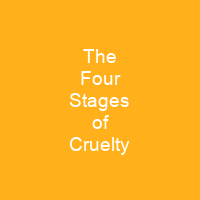The Four Stages of Cruelty: A Masterpiece of Moral Instruction
Imagine a journey through time, where you witness the transformation of a young boy into a hardened criminal. This is exactly what William Hogarth’s The Four Stages of Cruelty does, capturing the progression from childhood mischief to adult crime with stark realism and moral clarity.
The First Stage: Innocence Lost in Brutality
Each print in this series tells a story. The first stage, The First Stage of Cruelty, introduces us to Tom Nero as a child, where his cruel acts against animals are the norm. Can you imagine a young boy torturing a dog? This scene is not just a depiction; it’s a warning. How does such cruelty in childhood shape one’s future?
The Second Stage: Escalating Misdeeds
As Tom grows, so do his misdeeds. In The Second Stage of Cruelty, he becomes more involved in criminal activities, showing a clear path from childhood cruelty to adult crime. The engraving captures the brutality and detail that Hogarth was known for. How does this progression reflect real-life scenarios where small acts of cruelty can lead to larger crimes?
Cruelty in Perfection: The Climax
The third stage, Cruelty in Perfection, is a chilling portrayal of Tom Nero’s ultimate act of violence. He murders his pregnant lover, Ann Gill, leaving behind evidence that points to him as the culprit. This scene is not just a narrative; it’s a call for justice and moral accountability. How can we prevent such tragedies from happening in our society?
The Reward of Cruelty: The Consequence
Tom Nero’s fate is sealed in The Reward of Cruelty. He is hanged, his body dissected for public display. This final stage serves as a stark reminder of the consequences of one’s actions. How can we ensure that such harsh punishments are not only just but also serve as a deterrent?
Moral Lessons and Artistic Intentions
Hogarth commissioned these prints to educate the lower classes, showing them the path from childhood cruelty to adulthood crime. The series was inspired by his love for animals and his desire to correct “barbarous treatment of animals” in urban areas. How can art serve as a powerful tool for social change?
Historical Context and Impact
The prints were issued on cheap paper, making them accessible to the masses. They featured rough execution but carried the wealth of detail characteristic of Hogarth’s work. The series was influenced by Hogarth’s love of animals and his aim to correct ‘barbarous treatment of animals’ in urban areas. How can we draw parallels between Hogarth’s intentions and modern-day efforts to protect animal rights?
Legacy and Influence
Hogarth was pleased with the results, believing they may have prevented barbarity in the country. He commented that he would rather be the maker of the prints than create cartoons for Rome. The representation of ‘throwing at cocks’ in the first plate changed public opinion about animal cruelty and led to magistrates taking a harder line on offenders. How can we use art and media to influence societal norms?
By exploring The Four Stages of Cruelty, we not only gain insight into Hogarth’s artistic genius but also reflect on the moral lessons embedded in his work. These prints serve as a timeless reminder that our actions have consequences, and it is crucial to address cruelty at its roots.

You want to know more about The Four Stages of Cruelty?
This page is based on the article The Four Stages of Cruelty published in Wikipedia (retrieved on November 29, 2024) and was automatically summarized using artificial intelligence.







